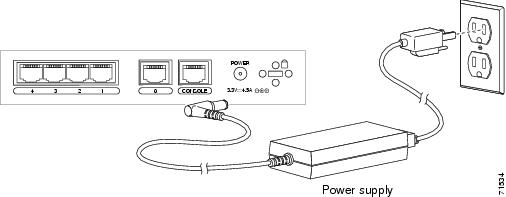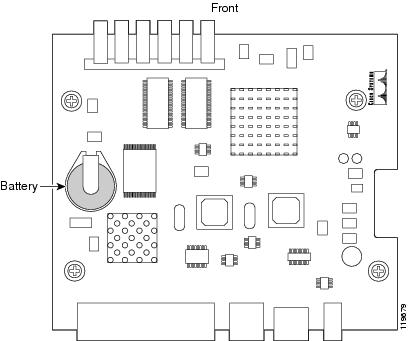

Table Of Contents
Connecting a Power Supply Module to the PIX 501
Removing and Replacing the PIX 501 Chassis Cover
PIX 501
This chapter describes how to install the PIX 501, and includes the following sections:
•
Connecting a Power Supply Module to the PIX 501
•
Removing and Replacing the PIX 501 Chassis Cover
Note
The PIX 501 is not supported in software Version 7.0(1).
PIX 501 Product Overview
This section describes the PIX 501 front and rear panels and the panel LEDs.
Figure 2-1 shows the front view of the PIX 501.
Figure 2-1 PIX 501 Front Panel
Figure 2-2 shows the rear view of the PIX 501.
Figure 2-2 PIX 501 Rear Panel
Figure 2-3 shows the PIX 501 front panel LEDs.
Figure 2-3 PIX 501 Front Panel LEDs
Table 2-1 lists the states of the PIX 501 front panel LEDs.
Installing the PIX 501
Place the PIX 501 on a flat, stable surface. The PIX 501 is not rack mountable.
To install the PIX 501, perform the following steps:
Step 1
Connect Port 0, the outside Ethernet port, to the public network.
•
Use the yellow Ethernet cable (72-1482-01) to connect the device to a switch or hub.
•
Use the orange Ethernet cable (72-3515-01) to connect the device to a DSL modem, cable modem, or router.
Step 2
Connect your PC or the other network devices to one of the four switched inside ports (numbered 1 through 4).
Connecting a Power Supply Module to the PIX 501
This section describes how to connect the power supply module to a PIX 501. Use this information in conjunction with the Regulatory Compliance and Safety Information document.
To connect the power supply module to the PIX 501, perform the following steps:
Step 1
Connect the small, round connector of the power supply cable to the power connector on the rear panel (see Figure 2-4).
Step 2
Connect the AC power connector of the power supply input cable to an electrical outlet.
Note
The PIX 501 does not have a power switch. Completing Step 2 powers on the device.
Figure 2-4 Connecting the Power Supply Module to the PIX 501
PIX 501 Cable Lock
The PIX 501 includes a slot that accepts standard desktop cable locks to provide physical security for small portable equipment, such as laptop computers (see Figure 2-5).
Figure 2-5 PIX 501 Security Cable Lock
To install a security cable lock, perform the following steps:
Step 1
Attach the cable lock to the lock slot on the back panel of the PIX 501.
Step 2
Follow the directions from the manufacturer for attaching the other end of the device for securing the PIX 501.
Removing and Replacing the PIX 501 Chassis Cover
This section describes how to remove and replace the chassis cover from the PIX 501. This section includes the following topics:
Removing the Chassis Cover
To remove the chassis cover, perform the following steps:
Note
Removing the chassis cover does not affect your Cisco warranty. Upgrading the PIX security appliance does not require any special tools and does not create any radio frequency leaks.
Step 1
Read the Regulatory Compliance and Safety Information document.
Step 2
Unplug the power cord from the power outlet to power off the security appliance.
Step 3
Disconnect the network interface cables.
Step 4
Turn the unit upside down so that the top of the chassis is resting on a flat surface, and the front of the chassis is facing toward you.
Step 5
Unscrew the single screw located on the bottom of the chassis, centered under the front panel (see Figure 2-6).
Figure 2-6 Removing PIX 501 Bottom Panel Screw
Step 6
Return the chassis to the upright position. Note that the chassis is comprised of two sections: top and bottom (see Figure 2-7).
Figure 2-7 Sliding the Chassis Cover Off the Chassis
Step 7
With the front panel facing you, slide the top section toward you, and then lift it up and off the bottom section (see Figure 2-7).
Replacing the Chassis Cover
CautionDo not operate PIX security appliances without the chassis cover installed. The chassis cover protects the internal components, prevents electrical shorts, and provides proper air-flow for cooling the electronic components.
To replace the chassis cover, perform the following steps:
Step 1
Place the chassis on a secure surface with the front panel facing you.
Step 2
Hold the chassis cover so the tabs at the rear of the chassis cover are aligned with the chassis bottom.
Step 3
Lower the front of the cover onto the chassis, making sure that the side tabs of the cover fit under the side panels of the chassis.
Step 4
Slide the chassis cover toward the front, making sure that the cover tabs fit under the back panel, and the back panel tabs fit under the chassis cover.
Step 5
Secure the chassis cover with the screw you set aside earlier.
Step 6
Reconnect the network interface cables.
Step 7
Place the PIX 501 on a flat, stable surface. The PIX 501 is not rack mountable.
Step 8
Reconnect the power cord to the power outlet to power on the security appliance.
Replacing a Lithium Battery
The PIX 501 has a lithium battery on the main circuit board (see Figure 2-8). This battery has an operating life of about ten years. When the battery loses its charge, the PIX security appliance cannot function. The lithium battery is a field-replaceable unit (FRU). You can use a standard 3V lithium battery to replace the used battery.
Figure 2-8 PIX 501 Lithium Battery Location
Warning
Danger of explosion exists if the lithium battery is incorrectly replaced. Replace only with the same or equivalent type recommended by the manufacturer. Dispose of used batteries according to the manufacturer's instructions.
To replace the lithium battery, perform the following steps:
Step 1
Remove the chassis cover as described in the "Removing the Chassis Cover" section.
Step 2
Use a flathead screwdriver to slide the battery out of the metal clip on the circuit board (see Figure 2-8).
Step 3
Place the used battery aside and replace it with a new battery. Install the new battery writing side up.
Step 4
The battery snaps into place as you slide it into the battery slot.
Step 5
Replace the chassis cover as described in the "Replacing the Chassis Cover" section.

 Feedback
Feedback










